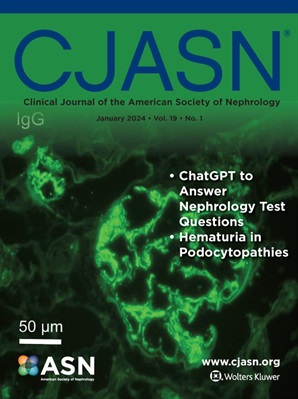Living donation and pregnancy complications: State of the evidence and ‘call-to-action’ for improved risk assessment
IF 8.5
1区 医学
Q1 UROLOGY & NEPHROLOGY
Clinical Journal of the American Society of Nephrology
Pub Date : 2024-09-20
DOI:10.2215/cjn.0000000593
引用次数: 0
Abstract
of donation on future pregnancies as well as the impact of pregnancy complications on postdonation outcomes. In February of 2023, the American Society of Transplantation Women’s Health Community of Practice held a virtual Controversies Conference on reproductive health, contraception and pregnancy after transplantation and living donation. Experts in the field presented the available data. Smaller breakout sessions were created to discuss findings, identify knowledge gaps and develop recommendations. Herein we present the conference findings related to living donation. The evidence reviewed shows that gestational hypertension and gestational diabetes mellitus pre-kidney donation have been associated with an increased risk of developing postdonation hypertension and diabetes mellitus respectively, without increasing the risk of developing an estimated glomerular filtration rate <45 ml/min postdonation. The risk of preeclampsia in living kidney donors increases to 4-10% and low dose aspirin may help reduce that risk. Little is known about the financial burden of living donors that become pregnant, their risk of postpartum depression or the optimal time between donation and conception. The data on living liver donors is even scarcer. The creation of a registry of donor candidates may help answer many of these questions and in turn educate prospective donors so they can make an informed choice. Living kidney and liver donation significantly increase the organ supply to make lifesaving transplant possible, offering a survival advantage to the recipient and cost savings to the society. Of all living donors 40% are women of childbearing age. However limited data exist regarding the impact of donation on future pregnancies as well as the impact of pregnancy complications on postdonation outcomes. In February of 2023, the American Society of Transplantation Women’s Health Community of Practice held a virtual Controversies Conference on reproductive health, contraception and pregnancy after transplantation and living donation. Experts in the field presented the available data. Smaller breakout sessions were created to discuss findings, identify knowledge gaps and develop recommendations. Herein we present the conference findings related to living donation. The evidence reviewed shows that gestational hypertension and gestational diabetes mellitus pre-kidney donation have been associated with an increased risk of developing postdonation hypertension and diabetes mellitus respectively, without increasing the risk of developing an estimated glomerular filtration rate <45 ml/min postdonation. The risk of preeclampsia in living kidney donors increases to 4-10% and low dose aspirin may help reduce that risk. Little is known about the financial burden of living donors that become pregnant, their risk of postpartum depression or the optimal time between donation and conception. The data on living liver donors is even scarcer. The creation of a registry of donor candidates may help answer many of these questions and in turn educate prospective donors so they can make an informed choice. Copyright © 2024 by the American Society of Nephrology...活体捐献与妊娠并发症:证据现状和改进风险评估的 "行动呼吁
捐赠对未来妊娠的影响以及妊娠并发症对捐赠后结果的影响。2023 年 2 月,美国移植学会妇女健康实践社区就移植和活体捐献后的生殖健康、避孕和怀孕问题举行了一次虚拟争议会议。该领域的专家介绍了现有数据。会议设立了小型分组会议,以讨论研究结果、确定知识差距并提出建议。我们在此介绍与活体捐献相关的会议结果。审查的证据显示,肾脏捐献前的妊娠高血压和妊娠糖尿病分别与捐献后罹患高血压和糖尿病的风险增加有关,但不会增加捐献后估计肾小球滤过率<45毫升/分钟的风险。活体肾脏捐献者患先兆子痫的风险增加到 4-10%,小剂量阿司匹林可能有助于降低这一风险。人们对活体捐献者怀孕后的经济负担、产后抑郁的风险或捐献与受孕之间的最佳时间知之甚少。关于活体肝脏捐献者的数据更是少之又少。建立一个捐献者候选人登记册可能有助于回答其中的许多问题,进而教育潜在的捐献者,使他们能够做出明智的选择。活体肾脏和肝脏捐献大大增加了器官供应,使挽救生命的移植成为可能,为受捐者提供了生存优势,也为社会节约了成本。在所有活体捐献者中,40% 是育龄妇女。然而,有关捐献对未来怀孕的影响以及怀孕并发症对捐献后结果的影响的数据十分有限。2023 年 2 月,美国移植学会妇女健康实践社区就移植和活体捐献后的生殖健康、避孕和怀孕问题举行了一次虚拟争议会议。该领域的专家介绍了现有数据。会议设立了小型分组会议,以讨论研究结果、确定知识差距并提出建议。我们在此介绍与活体捐献相关的会议结果。审查的证据显示,肾脏捐献前的妊娠高血压和妊娠糖尿病分别与捐献后罹患高血压和糖尿病的风险增加有关,但不会增加捐献后估计肾小球滤过率<45毫升/分钟的风险。活体肾脏捐献者患先兆子痫的风险增加到 4-10%,小剂量阿司匹林可能有助于降低这一风险。人们对活体捐献者怀孕后的经济负担、产后抑郁的风险或捐献与受孕之间的最佳时间知之甚少。关于活体肝脏捐献者的数据更是少之又少。建立捐献者候选者登记册可能有助于回答其中的许多问题,进而教育潜在的捐献者,使他们能够做出明智的选择。版权所有 © 2024 年美国肾脏病学会...
本文章由计算机程序翻译,如有差异,请以英文原文为准。
求助全文
约1分钟内获得全文
求助全文
来源期刊
CiteScore
12.20
自引率
3.10%
发文量
514
审稿时长
3-6 weeks
期刊介绍:
The Clinical Journal of the American Society of Nephrology strives to establish itself as the foremost authority in communicating and influencing advances in clinical nephrology by (1) swiftly and effectively disseminating pivotal developments in clinical and translational research in nephrology, encompassing innovations in research methods and care delivery; (2) providing context for these advances in relation to future research directions and patient care; and (3) becoming a key voice on issues with potential implications for the clinical practice of nephrology, particularly within the United States. Original manuscript topics cover a range of areas, including Acid/Base and Electrolyte Disorders, Acute Kidney Injury and ICU Nephrology, Chronic Kidney Disease, Clinical Nephrology, Cystic Kidney Disease, Diabetes and the Kidney, Genetics, Geriatric and Palliative Nephrology, Glomerular and Tubulointerstitial Diseases, Hypertension, Maintenance Dialysis, Mineral Metabolism, Nephrolithiasis, and Transplantation.

 求助内容:
求助内容: 应助结果提醒方式:
应助结果提醒方式:


